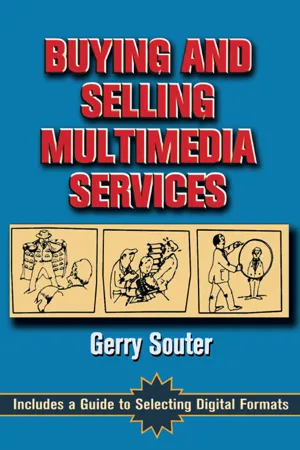![]()
Part One
![]()
1
What Is Multimedia?
First, let’s define what we mean by multimedia. Most companies have been using the elements of multimedia for years. The term multimedia was coined by author Joseph Klapper in his 1960 book, The Effects of Mass Communication. It meant the use of separate media in a single presentation. It started out as an adjective, graduated to a noun, became hyphenated (multi-media) and was swept into business communications as part of “AV” (audiovisual) presentations back in the 1970s. At that time, when computers were basically slow, clunky affairs compared to today’s home computers, there was only cine film, 35mm slides (single-advanced or programmed), overhead projection transparencies, and emerging videotape. A “computer” ran the slide show using paper punch-tape or beeps on 1/4-inch audio tape. To Steve Jobs and his sidekick Steve Wozniac, an apple was still a juicy red fruit.
AV coupled with computers had humble origins. A Commodore computer could run laser light shows. The Amiga was dying until someone stuffed a “graphics” chip inside, went searching for a niche market and, eventually, the graphic video effects offered by the “Toaster™” were available to producers and directors. Finally, Apple and IBM software writers became aware of the “presentation” industry, which went on to become the “computer graphics” industry.
Today, computers are ubiquitous. They unlock your car door, perk your coffee, and you can’t take notes at a meeting without opening up your Wizard, Psion, or other multifunction personal digital assistant. Parents once worried about their kids developing spatulate fingers from beating on computer keyboards all day. Today, you have three different carpal stress syndromes and those spatulate adults from the pre-mouse era are trying to find the keys on these teensy pocket computers or write on a screen with a “pen” that is only as thick as a cocktail stirrer.
With the successful introduction into the home of the computer-as-workstation, the ability to send faxes from the car seat via cellular phone, the explosion of 3-D graphics in high-power video games, the super-trendy Internet, and the merging of computers with high-speed fiber-optic lines, a huge new market has opened. Electronic entrepreneurs redesigned themselves as multimedia drumbeaters by kidnapping the term, abandoning its hyphen, and grafting it onto any computer-created presentation product.
Actually, multimedia embraces everything from virtual reality computer environments and CD-ROM extravaganzas, through traditional audiovisual uses, to multiscreen video walls, interactive training programs, satellite teleconferencing broadcasts, and Web sites on the beckoning Internet. The truth is that most of today’s computer-based “multimedia” is largely a digital presentation animal. How we get to the information has changed more than the makeup of its parts. Regardless of the sophistication of the user interface, the programs are created using still images, screen text, video clips, recorded audio, animation, and graphic design. All of these elements are cobbled into computer-readable bit/byte clusters waiting to be called on stage by the next line of program code launched from a hard drive, disk, card, or computer chip.
Good graphic design, cleanly recorded audio, well-directed quality video, and intelligent writing are combined through use of the wonderful new computer toolboxes now available. But a box of shiny new tools does not make a good mechanic. Creating any project from today’s lengthy menu of media possibilities is a team effort—a team of talented specialists. Finding the best creative interpreters for a given set of requirements is the challenge. Rarely do they live, or thrive, in the typical corporate atmosphere. When company downsizing comes, these bewildered folk are usually the first to hit the streets. It is virtually impossible for a company to justify having a staff large enough to cover all the variations of today’s corporate communications. Even the largest multimedia production houses can’t do that. The corporate project managers must sally forth to meet with, select, and work alongside creative specialists who can bring a program idea to life.
The problems facing companies who want to expand their marketing and training into the “new” digital multimedia age have not changed — the scope has merely widened. Where once the menu was table d’hôte, it is now a la carte; and if that were not all, the company must also think of the project in terms of what the new media combinations deliver. Over the years, our knowledge of what is “possible” tends to focus our perceptions such that we prefer to reject what is beyond our past experience. We cling to what we know. There is a comfort factor in the current way of approaching communications strategies and tactics: If what we are doing isn’t the best way, it would have been replaced. The bugs are out of the way we do it now. It is time tested. It was selected from other possibilities and has evolved into an acceptable procedure. We are already committed to the expectations of our loyal customer base. “If it ain’t broke, don’t fix it.”
Figure 1-1. A multimedia service company had an opportunity to move into the industry-rich environment of Taiwan. Important government contacts had been made, heavy insurance dollars committed, necessary permits filed, and a gala grand opening cocktail party thrown for all the important bigwigs. An office was opened in Taipei, stationery printed, and the search for clients begun. With a promise of a bright future before it, the plan had two fatal flaws: long-distance management and management rooted in a “… if it ain’t broke …” philosophy. First, a close examination of the sales effort would have revealed that the Taipei manager had no particular love for non-whites, in particular the Taiwanese. Also, like the company’s stateside sales reps, he knew very little about the technical side of multimedia communications. Second, all services sold in Taiwan had to be processed using the company’s facilities in the United States. Management rationalized that those expensive facilities had to be kept busy. Numerous similar facilities were available in Taipei at considerably less cost and did not have to pass through the nightmare of Taiwan customs. Eventually, fixation on what worked in the States, the inability to merge into Taiwan’s business culture, and management by fax doomed the project. A change in the company’s management style was perceived as “risky.” In a creative business, the company failed to recognize that the basis for creativity is the seeking of alternatives.
Many of today’s corporate marketing people peering out across the multimedia landscape also have the urge to equate something that is new with risk. Yet, understanding that today’s “new” is simply an alternative packaging of familiar forms of media into new formats for presentation takes some of the scary edge off risk.
The company must also consider a changing audience for its project. Media literacy has increased through exposure. Television, movies, video games, the Internet, home computers, cellular phones, fax machines — people are accepting the information exchange explosion in exponentially greater numbers. They are becoming techno-hip. This hipness is due largely to the fact that access to this information exchange has been made easier. An intimate knowledge of techno-speak is no longer required for membership — though a soupçon of the fundamentals helps as we’ll discuss later. A growing number of techno-seers have had a revelation. The easier it is to join the club, the more dues you collect. Commerce and creativity are no longer mutually exclusive realities. It is not a “dumbing down” of creative effort, it is a raising of everyone’s collective appreciation because we — companies and production houses — can both finally get our arms around the product.
Now, we have the shiny tools and we have our hip audience. How do we use the former to communicate with the latter? One key to creating any successful project outside of the company’s in-house operation is to understand that the tool wielders beyond the company gate are also companies. They may have an employee roster of one, or a hundred, but they are out to make a profit, grow their businesses, put a little away in the fruit jar buried under the porch, and send their kids to college. They are exchanging their expertise for money and most of them want to produce a product they can be proud of while preparing the ground for a long-term relationship with their clients. There is no secret handshake or mystic incantations. They’re just folks.
But one thing above all others I’ve mentioned is the absolute truth — the vendors approached to bid on and execute your multimedia project are on the clock from the first meeting to discuss the proposal to the last wrap-up day when the final billing goes out. There is no “cost of doing business” once a project is won. The hours spent in meetings with your team, on storyboards, on the phone, on internal meetings between members of the vendor’s team to discuss your project, and so on, are all considered to be billable hours in one way or another when the bottom-line budget is totaled up. The clearer the path from client concept to project wrap-up, the more money will be saved. This point will be constantly reemphasized throughout the narrative.
![]()
2
Prelaunch Thoughts
The normal route for bringing multimedia artisans to the corporate front door is to send out a missal announcing the company’s stated needs accompanied by a request for proposal (RFP).
I spent 8 years with a Fortune 500 company learning how to write an RFP to buy multimedia. For 11 years after that, I tried to decipher prospective client proposal requests so we could sell multimedia. During both internships, the good, the bad, and the ugly passed through my hands. Worst of all, during those last years, I fielded far too many prospective client telephone requests for a “ballpark” budget.
Even if—by some stroke of whimsy — we won the job, costly hours on the clock would be spent trying to untangle the client’s best intentions to create a project that would accomplish the job. Of course, the “ballpark” number roughly arrived at will, very likely, have become engraved on the client’s frontal lobe and when the whole of the project comes to light, the actual cost may exceed that first groping guesstimate. Then, a great shout and clamor goes up and accusations of “bait and switch” can arise during the fingerpointing. The time taken to prepare a well-thought-out RFP in most cases could have saved hundreds and sometimes thousands of dollars.
Some clients have gone to the well with a hole in their bucket a few times and had a bad experience. Their RFPs are masters of self-defense: pages long, they resemble tech manuals and specify elements down to the tiniest detail. Unfortunately, the well keeps getting deeper as new technology comes along. They are often so entrenched in their narrow perception of the media marketplace and armored with their minutely delineated specs that they stubbornly rule out very creative and cost-effective possibilities.
Figure 2-1. “… We’re gonna make a video about a new service—can’t tell you what it is because it’s confidential. Usually, Leo in marketing shoots our video films for training. He’s got his own camera. We figure no longer than 30 minutes. Mr. Smartfingerfulcher, our founder, will introduce it and we’ll shoot around the plant for a day. Our tech writer will do the script and you can polish it. Probably want some graphics too and can you fax me your numbers by tomorrow afternoon?… Do we have a budget in mind? Well, that’s your job isn’t it? Tell us what you think it will cost… just a ballpark number.”
The multimedia buyer must think through the pending project with regards to the people who will be reading the RFP. Even without a clear knowledge of all the multimedia tools available, certain basic premises can be outlined. These will guide the project team toward a choice of media and the vendor who can supply it.
• What is the project’s objective? To motivate sales? Introduce a product or service? Draw crowds to a trade show booth? Add dynamic elements to a meeting? Train personnel in a new procedure or product features? Present the company’s story and image? Improve internal communications?
• Who is your audience? What will they be looking for? What have they seen before? Is their point-of-view represented in your project team?
• What is the venue for the presentation of the project (a meeting, trade show, point-of-purchase location, small group in a conference room, individual workstation, a site on the Internet, television or satellite broadcast, etcetera.)?
• What’s your real budget? What is the total amount available to spend on the project? Do the participating departmental money providers demand sign-off on the elements of the project before committing the cash? Are they represented in your project team? (Turf wars are to be avoided at all costs once a project is awarded at a given budget.)
• How much of that budget do you want to actually spend? Should there be a cushion to allow for the unknown, unforeseen changes that can occur in a project? (We’ll talk about “unforeseen” changes later.)
• What kind of media will best do the job?
Part Two of this book discusses in reasonable detail various specific media available to deliver the product to the audience, but first one or two words about the reasons behind choices are appropriate here.
Driven by the latest buzzwords sputtering out of the press, sometimes a client will choose a medium because it’s “hot!” At other times, other mediums are chosen, because the client has a “comfort level” with the medium they have used before.
There are so many technologies available to clients that to try to wedge a need into a trendy format is as bad as sticking to a format because that’s “what’s always been used.” The target audience and the result expected from the experience should be a major factor in choosing the medium and presentation format.
Figur...



